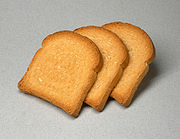
Zwieback
Encyclopedia

Bread
Bread is a staple food prepared by cooking a dough of flour and water and often additional ingredients. Doughs are usually baked, but in some cuisines breads are steamed , fried , or baked on an unoiled frying pan . It may be leavened or unleavened...
, made with eggs
Egg (food)
Eggs are laid by females of many different species, including birds, reptiles, amphibians, and fish, and have probably been eaten by mankind for millennia. Bird and reptile eggs consist of a protective eggshell, albumen , and vitellus , contained within various thin membranes...
and baked twice.
It is sliced before it is baked a second time, which produces crisp, brittle
Brittle
A material is brittle if, when subjected to stress, it breaks without significant deformation . Brittle materials absorb relatively little energy prior to fracture, even those of high strength. Breaking is often accompanied by a snapping sound. Brittle materials include most ceramics and glasses ...
slices that closely resemble melba toast
Melba toast
Melba toast is a very dry, crisp and thinly sliced toast often served with soup and salad or topped with either melted cheese or pâté. It is named after Dame Nellie Melba, the stage name of Australian opera singer Helen Porter Mitchell. Its name is thought to date from 1897, when the singer was...
. Zwieback is commonly used to feed teething
Teething
Teething is the process by which an infant's first teeth sequentially appear by emerging through the gums. Teething may start as early as three months or as late, in some cases, as twelve months. The typical time frame for the first teeth to appear is somewhere between six and nine months...
children, and as the first solid food for patients with an upset stomach.
The name comes from German
German language
German is a West Germanic language, related to and classified alongside English and Dutch. With an estimated 90 – 98 million native speakers, German is one of the world's major languages and is the most widely-spoken first language in the European Union....
zwei ("two") or zwie ("twi-"), and backen, meaning "to bake". Zwieback hence literally translates to "twice-baked".
Zwieback originated in East Prussia, Germany. The Mennonite
Mennonite
The Mennonites are a group of Christian Anabaptist denominations named after the Frisian Menno Simons , who, through his writings, articulated and thereby formalized the teachings of earlier Swiss founders...
s brought Zwieback to Russia (now Ukraine); during and after the Russian Revolution, they brought Zwieback to Canada, and other parts of the world.
See also
- BiscottiBiscottiBiscotti more correctly known as biscotti di Prato , also known as cantuccini , are twice-baked biscuits originating in the Italian city of Prato...
- Brandt (company)Brandt (company)Brandt Zwieback-Schokoladen GmbH + Co. KG is a zwieback and chocolate producer in Germany. The company was established in 12 October 1912 in Hagen by Carl Brandt. In 2007, director Peter Scharf made a documentary on the company's history for WDR....
- RuskRuskA rusk is a hard, dry biscuit or a twice-baked bread. It is sometimes used as a baby teething food. In the United Kingdom, the name also refers to a wheat-based food additive.- Germany :The zwieback A rusk is a hard, dry biscuit or a twice-baked bread. It is sometimes used as a baby teething food....
- Russian Mennonite zwiebackRussian Mennonite zwiebackRussian Mennonite zwieback is a yeast bread roll formed from two pieces of dough that are pulled apart when eaten. Placing the two balls of dough one on top of the other so that the top one does not fall off during the baking process is part of the art and challenge that must be mastered by the baker...
(Tweebak) - ToastToastToast is bread that has been browned by exposure to radiant heat. This browning reaction is known as the Maillard reaction. Toasting warms the bread and makes it firmer, so it holds toppings more securely...

